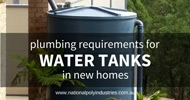
When installing a rainwater tank and you want to use your harvested water throughout your house, then you will obviously need some plumbing work carried out. Such as:
- fitting downpipes from your roof to your tank
- connecting your tank overflow to a stormwater system
- connecting your tank to a pressure pump, etc.
Depending on your location and the size of your tank, in some instances you might even require council approval. For example, in NSW if you install a rainwater tank greater than 10,000 litres then you require council approval.
When installing a rainwater tank and connecting it to supply outlets within a property, Australian Standards exist for plumbing and drainage (AS/NZS 3500) and are endorsed and required by government. This standard includes a section that specifically deals with the minimum plumbing industry standards for water supply systems from rainwater tanks.
Where rainwater is used to service toilets or a laundry, an automatic or manual rainwater to mains water switch device usually must be installed. This ensures a continual supply of water is available. Different states and areas might require you to specifically use an automatic switching device, since they make more efficient use of your rainwater.
All piping systems delivering rainwater to taps, fixtures, outlets or appliances must be installed by an appropriately licensed plumber. It is important to check that the plumber is licensed in your state, since different states often have different regulations. You may also need to lodge a plumbing alteration form with your local water authority prior to work commencing.
Where you have an interconnection between your rainwater tank and mains water supply, such as would be the case with a rainwater to mains water switch, then a backflow prevention device needs to be installed. This is to protect your rainwater supply passing backwards through the water meter and entering the mains water supply.
Backflow prevention devices are rated low, medium and high. If your water tank being plumbed into your house is partly or completely buried, the potential for water contamination increases. A high hazard rated testable backflow prevention device is normally required in such cases. Otherwise, for above ground tanks, a medium hazard device is normally acceptable.
Testable backflow prevention devices often need to be registered with your local water authority and authorised prior to use. In addition, such devices must be tested annually by a suitably qualified plumber with a copy of the test report provided to the water authority.
The information provided above may differ from one state and location to the next. While we do not warrant that it is correct or accurate for your particular situation, it should give you a good idea of what to expect. It is very important that you contact your local council and water authority to ensure you fully comply with any and all requirements.

